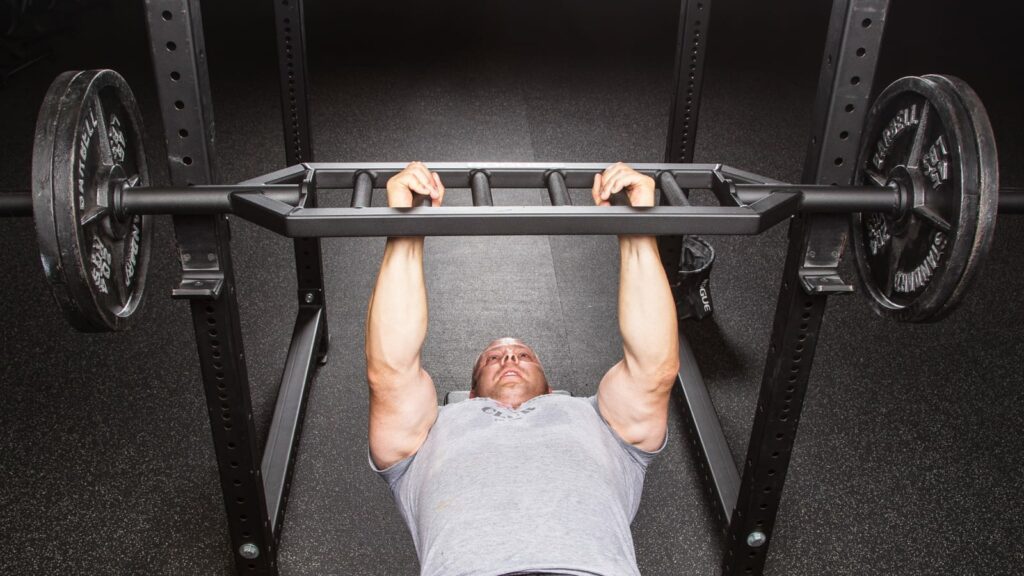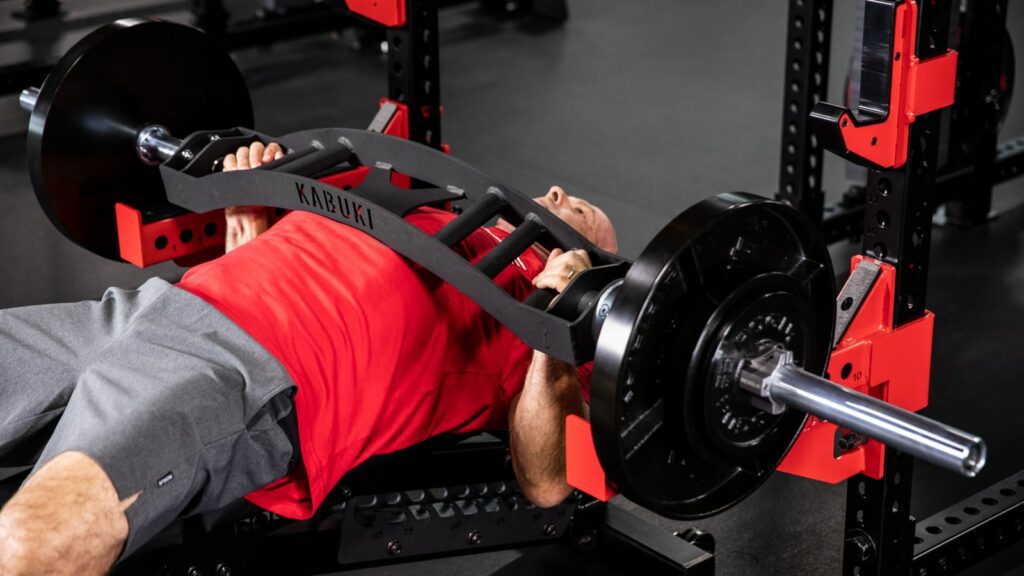When it comes to enhancing the quality of our workouts, choosing the right equipment is crucial.
You may have come across the Swiss bar or football bar, two specialty bars designed to improve your pressing movements.
But which one should you use? Is one better than the other? Or do they serve similar purposes?
In this article, we’ll delve deep into the world of these two unique bars, comparing their benefits, uses, and ensuring you have all the information you need to make an informed choice.
Let’s get started!
Table Of Contents
- 1 Where Do They Get Their Names From?
- 2 Swiss Bar & Football Bar Dimensions
- 3 How to Use a Multi-Grip Bar?
- 4 Factors to Consider When Purchasing a Swiss or Football Bar
- 5 Advantages of Using a Swiss or Football Bar
- 6 Does the Cambered Bar Weigh More Than the Swiss Bar or Football Bar?
- 7 Can an EZ Bar Help Build Bigger Arms Compared to Swiss and Football Bars?
- 8 Frequently Asked Questions
- 8.1 Is the Swiss bar bench easier or harder?
- 8.2 Is a Swiss bar better than a barbell?
- 8.3 Are Swiss bars worth it?
- 8.4 Why use a Swiss bar for bench press?
- 8.5 What is the point of the Swiss bar?
- 8.6 Should I buy a Swiss bar?
- 8.7 What muscles do the Swiss bar work?
- 8.8 Why would you choose the football bar over the Swiss bar for non-athletes?
- 9 Conclusion
Where Do They Get Their Names From?
The Swiss bar and the football bar are two distinct types of specialty bars, and their names have intriguing origins.
The Swiss bar, often referred to as a “multi-grip bar”, is believed to have been named after its country of origin or its inventor.
Its design features multiple straight and angled grips, which allow for a variety of hand placements during pressing exercises.

This versatility in grip positions is one of its hallmark features, and the name “Swiss” signifies its multifunctional nature, similar to a Swiss Army knife.
For more on the benefits of the Swiss bar, check out this detailed article.
On the other hand, the football bar is often associated with training athletes, particularly football players.
Its unique grip design, especially the angled grips, helps minimize stress on the wrists and shoulders.

While its name might suggest a connection to the sport of football, the exact origin of the name is not universally agreed upon.
However, its design benefits athletes, especially those who need to ensure the quality of their workouts without putting undue strain on their joints.
For a deeper dive into the various types of barbells available, this article provides a comprehensive overview.
Swiss Bar & Football Bar Dimensions
When deciding between the Swiss bar and the football bar, one essential factor to consider is their dimensions.
Both bars are designed for specific uses, and understanding their size can help determine which one is better suited for your needs.
The Swiss bar typically measures around 78″ (6.56 feet) in length and weighs anywhere from 35-55 pounds, depending on the manufacturer and the material used.
Its multi-grip design offers both straight and angled grip positions, spaced at varying intervals to accommodate different hand widths and exercise variations.
For more on specialty barbells, you can explore this article.
The football bar, on the other hand, is around the same length and weight.
The primary distinguishing feature of the football bar is its angled grips, which are specifically designed to reduce wrist and shoulder strain during pressing movements.
To understand more about the different bench press bars, this article offers valuable insights.
How to Use a Multi-Grip Bar?
Using a multi-grip bar, whether it’s a Swiss bar or a football bar, can significantly improve the quality of your pressing exercises.
Here’s a step-by-step guide on how to use one:
- Choose the Right Grip – The multi-grip design offers both straight and angled grips depending on the barbell you own. Depending on the exercise and your comfort, select the grip that suits you best. For instance, the angled grips on a football bar can be particularly beneficial for those with wrist issues.
- Position Your Hands – Ensure your hands are evenly spaced and that you have a firm grip. This will not only enhance the effectiveness of your exercises but also ensure safety.
- Pressing Movements – Whether you’re performing a bench press, overhead press, or any other pressing exercise, the Swiss bar’s multi-grip design adds a unique dimension. This design not only offers versatility in hand placement but also allows users to target specific muscle groups more effectively, adding both variety and precision to workouts.
For more detailed instructions and exercises using a multi-grip barbell, check out this comprehensive guide.
Factors to Consider When Purchasing a Swiss or Football Bar
If you’re in the market for either a Swiss bar or a football bar, there are several factors to consider to ensure you make an informed decision:
- Purpose – Determine what you intend to use the bar for. Is it for rehab exercises, strength training, or something else? This will influence which bar is better suited for your needs.
- Grip Options – Look for a bar that offers multiple grip options, both straight and angled. This provides versatility in your workouts.
- Material and Build Quality – Ensure the bar is made of high-quality materials that can withstand heavy weights and regular use.
- Price – While it’s essential to invest in quality, also consider your budget. There are various options available in different price ranges.
- Reviews and Recommendations – Before making a purchase, read reviews from other users and seek recommendations. This can provide insights into the bar’s performance and durability.
For more on choosing the right barbell for your needs, this article offers valuable tips and recommendations.
Advantages of Using a Swiss or Football Bar
The Swiss bar and football bar, with their unique designs and grip options, offer several advantages that can significantly improve your workout quality:
- Reduced Joint Stress – The angled grips, especially in the football bar, help reduce wrist and shoulder strain during pressing movements, making it a preferable choice for those with existing joint issues.
- Targeted Muscle Activation – The multiple grip options allow users to target specific muscle groups, offering a more versatile workout experience.
- Improved Stability – Due to the neutral grip, these bars can enhance shoulder stability and reduce the risk of injuries.
- Variety in Workouts – Incorporating either of these bars can break the monotony of standard barbell workouts, introducing new challenges and variations.
- Rehabilitation – They can be especially beneficial for individuals recovering from injuries, as they allow for pressing movements without causing undue stress on the joints.
Does the Cambered Bar Weigh More Than the Swiss Bar or Football Bar?
The typical weight of a cambered bar differs from that of a Swiss bar or a football bar.
While the weight may vary depending on the specific make and model, cambered bars generally tend to weigh more due to their structural design.
The Swiss bar and football bar, on the other hand, typically have a lighter weight in comparison.
Can an EZ Bar Help Build Bigger Arms Compared to Swiss and Football Bars?
An EZ bar can be an effective tool for building bigger arms.
Compared to Swiss and football bars, an EZ bar’s angled shape puts less strain on the wrists and allows for a more comfortable grip during exercises like bicep curls and tricep extensions.
This can improve form and target the muscles more effectively, resulting in enhanced muscular development.
Frequently Asked Questions
Conclusion
Choosing between the Swiss bar and the football bar comes down to individual needs and workout goals.
Both bars offer unique advantages that can enhance the quality of your pressing exercises.
Whether you’re an athlete, a home gym owner, or someone recovering from an injury, incorporating either of these bars can provide both variety and benefits to your regimen.
Which bar intrigues you more? Let me know in the comment section below right now!
Until next time,
-Dante